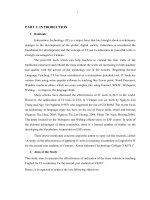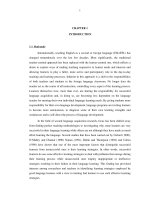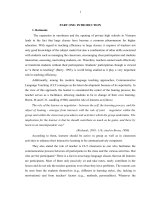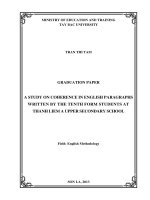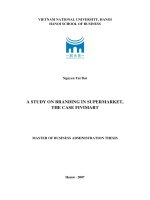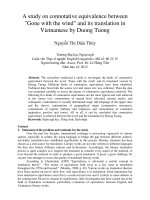Study on constraints in seeking information by the rural women and their suggestions
Bạn đang xem bản rút gọn của tài liệu. Xem và tải ngay bản đầy đủ của tài liệu tại đây (186.96 KB, 11 trang )
Int.J.Curr.Microbiol.App.Sci (2017) 6(3): 2105-2115
International Journal of Current Microbiology and Applied Sciences
ISSN: 2319-7706 Volume 6 Number 3 (2017) pp. 2105-2115
Journal homepage:
Original Research Article
/>
Study on Constraints in Seeking Information by the Rural Women
and their Suggestions
Divya Pal1, R.R. Yadav1, Prakash Singh2, Shesh Narain3,
Vandana Gautam1 and Manoj Kumar2*
1
Home Science Extension and Communication Management, N.D.U.A & T., Narendra Nagar
(Kumarganj), Faizabad (U.P.) 224229, India
2
Department of Extension Education, College of Agriculture,N.D.U.A & T., Narendra Nagar
(Kumarganj), Faizabad (U.P.) 224229, India
3
SMS (Agriculture Extension) K.V.K Masodha Faizabad (U.P.), India
*Corresponding author
ABSTRACT
Keywords
Information, Seeking,
Communication
media, Rural women.
Article Info
Accepted:
20 February 2017
Available Online:
10 March 2017
The study was conducted in Milkipur block of Faizabad district (U.P.) selected
purposively. A total number of 100 respondents were selected through random
sampling four sample villages on the basis of highest area under Agriculture of the
respondents. The majority of the respondents 35.00% were found in medium
categories (29-42) of age group, (80 %) literate, (41%) backward caste, (31%)
nuclear family, (43%) size of family, (24%) small size of landholding, (22%), in
services, (41%) Agriculture as their main occupation, (60%), pucka houses,
(55%), no participation in any organization, (65%), annual income, was found in
medium categories, respectively.
Introduction
The information needs; demands and wants
have been used interchangeably, although
they may not be identical. Information need
involves a cognitive process which may
operate on different levels of consciousness
and, hence, may not be clear even to the
inquirer him/her. People in different situations
require information on a subject in different
forms and with different emphasis and
different depth of explanation. Even the same
person seeks information in different ways
and forms on various occasions depending on
his/her knowledge of the subject and the
reasons for wanting the information. So the
information need is very difficult to define
and categorize. They are the recipients of an
iniquitously small share of development
opportunities. Their access to education,
nutrition, health care, skill formation, jobs and
decision making is very limited. Many
customs cause them harassment. Wage
discrimination and gender bias are both
visible and widespread. Generally they are
employed in low paid, low producing sectors,
despite a lot of laws enacted for
conceptualizing the equal status of women.
After Independence many steps have been
taken to improve the lot of women. Many
laws have also been passed. A National
Commission on Women was setup to act as a
2105
Int.J.Curr.Microbiol.App.Sci (2017) 6(3): 2105-2115
watchdog on the matters concerning women
in 1992. Many Programmes in the areas of
education, health and employment have been
initiated for development of women, rural as
well as urban.
Information is the basic material for the
decision making process. People need
information, right from the organizational
level to the personal level, from the highly
educated and experience person to school
children, from a very famous person to an
ordinary person, for taking the right decision
in every step of life. In this information age
there is so much of information being
generated that we are confronted with growth
of information which leads to information
explosion, exponential information pollution.
Due to information explosion or information
pollution, the people are confused about the
information need, information access and
information sources. Again information
access varies from person to person according
to their needs. Thus, information seeking is a
kind of communication behavior, which
surely be influenced by many factors. It also
involves personal reasons for seeking
information, the kind of information which
sought, and the ways and sources with which
needed information is sought.
Information needs and information seeking
pattern /behavior is a kind of communication
behavior, which surely be influenced by many
factors. Rural people are aware of their
information needs. As a developing country,
the features that characterized the rural
population in India include illiteracy, poverty,
hunger, disease, and general absence of basic
infrastructure such as roads, schools,
electricity, etc. These coupled with peculiar
problems of rural population such as early
marriages, lack of income, withdrawal of
students from school has created indolence
towards any form of developmental efforts. A
recent UNESCO report revealed that the level
of poverty in the country is increasing at an
alarming rate and the situation is worst in the
Northern part, particularly the North East
where Barak Valley is situated.
Women, form about half of the population of
the country, but their situation has been grim.
For centuries, they have been deliberately
denied opportunities of growth in the name of
religion and socio-cultural practices. Before
independence, women were prey to many
abhorrent customs, traditional rigidities and
vices due to which their status in the society
touched its nadir and their situation was allround bleak. At the personal social plan,
women were victims of widespread illiteracy.
Women’s education and empowerment have
been important social economic and political
issues in the developing countries like
Bangladesh and over the past three decades
Bangladesh has made impressive gains in
these areas. Women are now participating in
family decision making as well as in national
and international socio economic and political
development.
Women irrespective of location need
information on family health food and
nutrition family planning and child education
but rural women also need information
regarding agriculture and animal husbandry
for their involvement in socio economic
growth. However the women who live in
villages have lack of access to information
resources and inability to have access to
information and communication technology.
The rural women are remained as unexploited
natural resources and the whole nation would
be benefited if they are properly involved in
the development activities in a planned Way
(Agriculture Information services AIS 2004)
library or information centers can irrigate
information needs of rural women through
access to relevant information and can enable
rural women of Bangladesh participating in
the national economic development.
2106
Int.J.Curr.Microbiol.App.Sci (2017) 6(3): 2105-2115
Information is the basic material for the
decision making process. People need
information, right from the organizational
level to the personal level, from the highly
educated and experience person, for taking
the right decision in every step of life. In this
information age there is so much of
information being generated that we are
confronted with growth of information which
leads to information explosion, exponential
information pollution. Due to the information
explosion or information pollution, the people
are confused about the information need,
information access and information sources.
Again information access varies from person
to person according to their needs. Thus,
information seeking is a kind of
communication behavior, which surely be
influenced by many factors. It also involves
personal reasons for seeking information, the
kind of information which sought, and the
ways and sources with which needed
information is sought.
According to Davidson and Lingam (1997),
the understanding of information needs and
information seeking behavior of various
professional groups is essential as it helps in
the planning, implementation and operation of
information system and service in the given
work setting. Information need is often
understood information science as evolving
from a vague awareness of something missing
and as culminating in locating information
that contributes to understanding and meaning
(Kuhlthau, 1993). Information need is
described as an anomalous state of knowledge
or a gap in individual’s knowledge in sense
making situations (Drevin and Nilan 1986).
Information seeking is a basic activity
indulged in by all people and manifested
through a particular way of behavior. It is also
an aspect of scholarly work most interesting
to academic librarian who strives to develop
collections, services, and organizational
structures that facilitate seeking of
information. Information seeking behavior is
a broad term which involves a set of actions
that an individual takes to express information
needs , seeking information , evaluate and
select information and finally uses this
information to satisfy her information needs
varies factors may determine the information
seeking behavior of an individual or a group
of individuals. It is, therefore desirable to
understand the purpose for which information
is required, the environment in which the user
operates users skills in identifying the needed
information, channels and sources preferred
for acquiring information and barriers to
information.
In agricultural knowledge and information
system, people and institutions are linked
together to promote and enable mutual
learning and generate, share and use
agriculture related technology, knowledge
skills and information. The compatibility of
the resources is another important factor
which helps the process of adoption of house
and agricultural innovations. The aspect is
generally overlooked by most of the extension
agent, and the genuine difficulties of the
women due to their limited resources are
generally taken as indicator of their apathy.
Thus, it makes our extension agent somewhat
biased in their approach this situation causes a
setback to the effectiveness of the house and
agricultural communication and consequently
makes the task of the extension agent even
more challenging and difficult.
Today, a number of communication media
and channels are used for dissemination
improved house and agricultural information
and technology to the women. While,
communicating information though media it
is necessary to take into account the
preference of the women for a particular
information media. The women may come
across a number of information sources
2107
Int.J.Curr.Microbiol.App.Sci (2017) 6(3): 2105-2115
credibility is decided by the degree of
trustworthiness accorded at a given time. We
can depend upon, as a source of information,
on information publications that are published
by central and state government and other
originations.
Motion
pictures,
films,
exhibitions, newspapers, home science books,
success story of women, meetings,
conferences, radio broadcast, TV. Telecast,
research releases. From the home science
research stations etc. are good sources of
information. Some time the private industries
inputs are also a good source of information
for home sector.
There are many sources/ channel of
information through which women seek
information on house level and it is obvious
that no one channel that is effective or best for
all situations. What is needed is a parreled
communication of channel in order to have
the intended impact proper selection and use
of channels is very important in order to reach
a given audience and to achieve
predetermined objective. It is also being noted
that some women are exposed to a relatively
large no. of information sources and with
greater frequency than other. Information
played an important role in our societies since
the down of civilization. However, in recent
years its increase in volume and accuracy as
well as greater access, have significantly
elevated its value in all aspects of social life.
The world community has recognized the
revolutionary nature of information society
the world is undergoing an information
communication technology revolution, a
revolution that has enormous social economic
implication for the developed and developing
countries. Science and technology has
undergone revolutionary changes in recent
past. Only a few decades ago, all
telecommunications services were delivered
over copper wires. More recently, the world
has witnessed the exponential growth of
information and communication technology.
Today the dazzling collection of new
technologies, services and applications has
led to a digital age in which access has
become a key component of people lives.
Information and communication technologies
comprise a diverse set of technological tools
and resources to create, disseminate, store and
manage data and information. Traditional
information tools e.g. T.V., Radio and
telephone have already established their
credibility and effectiveness in promoting the
developmental schemes in rural and
marginalized areas, the modern information
and communication tool are computer,
internet
and
wireless
communication
technology along with powerful software
which can process and integrate sound , text
and video in to electronic media. The
information and communication technologies
can create new opportunities to bridge the gap
between information haves and information
has not in the developing countries. It is very
clear from the sources and channels of
information used by the rural women, that
there information seeking behavior are mainly
informal. They align more to information
gotten from friends, relatives, husband, sons,
daughter and market women .this according to
Mommoh (2002), is because “those sources to
them are more reliable and authentic” it can
also be seen to be in conformation of Zipfs
(1949) principles of least effort in human
behavior. The rural woman hardly seeks
information in a formal way through formal
sources or channels .watching TV. Or
listening to radio where available is seen as
luxury only man cans effort.
Information seeking behavior is one of the
important key concepts of user’s study which
covers various facets like information, need,
use, access pattern, behavior in different
environment, etc. Crombie (1997) in his
convocation address Avnashilingam Institute
for Home Science and Higher Education for
2108
Int.J.Curr.Microbiol.App.Sci (2017) 6(3): 2105-2115
Women stated that the inequalities faced by
women arise from attitudes, perceptions and
prejudices that are difficult to change. The
information needs; demands and wants have
been used interchangeably, although they may
not be identical.
Information need involves a cognitive process
which may operate on different levels of
consciousness and, hence, may not be clear
even to the inquirer her. People in different
situations require information on a subject in
different forms and with different emphasis
and different depth of explanation. Even the
same person seeks information in different
ways and forms on various occasions
depending on her knowledge of the subject
and the reasons for wanting the information.
So the information need is very difficult to
define and categorize.
In traditional society, women were supposed
to do housework, take care of children, and
give the family emotional stability. However,
with the social and economic changes that
affect our urban and rural society, the
traditional values also change. More women
are engaged in full-time jobs. No longer are
they only women and mothers; they are also
business women, politicians, and contributors
to society. Rural women, who in most cases
do not have full time jobs, have also exposed
themselves on various fields of financial
acquisitions including commerce, service and
agriculture. These require them to know how
to perform these economic activities in order
for them to get more return on their effort.
They need to know the way to grow
vegetables, how to produce a marketable
product and how to advertise the services
provided. For instance, a group of women
have run a traditional cake production in
Nigeria Sembilan (Ministry of Agriculture &
Agro-Based Industry, n.d.). Women staying at
home also can run business through
application of information technology through
marketing and advertisement.
Since 1991, the government of Malaysia has
included in its five-year development plans, a
dedicated
chapter
on
Women
and
Development. On the whole, these have
primarily regarded women as resources to be
mobilized for national good. A woman has
been participating actively in the nation’s
development. The ability and capability of
women have been harnessed fully without any
form of discrimination. For example the
figure for student’s enrolment in university is
currently shows female and male students
registered at the university at 69 percent and
31 percent respectively. Despite progress
made by women in all key economic sectors
in Malaysia, the majority of women remain
concentrated in low skilled and low waged
jobs and very few in top managerial and
decision-making posts. Women living in rural
and remote areas in Malaysia have been
documented as lagging behind that of their
urban-dwelling counterparts in terms of
wealth and literacy. Malaysia’s poverty has
been a predominantly rural phenomenon.
A study done by Mohd Noor (2007) found
that “There exists a disparity between the
digital/information
rich
and
the
digital/information poor among various
groups in Malaysia. Coincidently, the pattern
is that the former is located in urban areas
whilst the latter in rural, as similar scenario as
in the case of poverty. Regardless of location,
however, women tend to be the primary
seekers of information for their children and
other family members, as well as for
themselves in rural Malaysia, more often than
not; these women will perform the tasks of
women for the family. It is pertinent to note
here that in the rural setting there is a strong
kinship relationship that existed among the
villagers, especially among the community of
women in the villages. It is believed that
women roles have an impact on families and
societies. If they perform accordingly their
roles and duties, a quality generation will be
produced. Of course in order to achieve that, a
2109
Int.J.Curr.Microbiol.App.Sci (2017) 6(3): 2105-2115
sufficient amount of information is a
necessity. Here, libraries could play an
important role of supplying enough
information for them. In addition to taking
care of the family, a house wife is also
expected to know something on health
matters, children education and the family
economics.
Information is an important resource for
individual growth and survival. The
progresses of Modern societies as well as
individuals depend a great deal upon the
provision of the right kind of information, in
the right form and at the right time.
Information is needed to be able to take a
right decision and also reduce uncertainty. A
businessman needs information to be able to
improve in his existing business just like a
specialist also need information to be up-todate and well informed in his area of
specialization. If information is this valuable,
it must be put to proper use, i.e. made
available to people or group of people who
need it, after ascertaining the group’s
information needs and seeking behavior.
The Webster’s dictionary sees “Rural” as
relating to or characteristics of people who
live in the country opposed to urban,
characterized
by
simplicity,
lacking
sophistication and engaged in agricultural
pursuits. To Nzirimo, rural people (which by
the
implication
rural
women)
are
characterized by the following; extreme
poverty, malnutrition, lack of electricity,
inadequate school facilities, with inexperienced teachers, inadequate and poor
media facilities since rural women are women
that live in the rural areas mostly illiterates,
their jobs activities are bound to be unskillful
jobs that does not require expertise, they
involved in house-keeping and farming.
Oxford dictionary defined “Artisan” as
someone who uses traditional skills and tools
to make thing. Wikipedia went further to
describe Artisan as a skilled manual worker
who makes items that may be functional or
strictly decorative including furniture,
clothing and jewelry household items and
tools or machines such as handmade device of
a watch maker. It is also a person that engages
in or occupied by the practice of a craft, who
may through experience and talent reach the
expressive levels of an art in their work and
what they create.
Awasthi (2004) posits that outside farming,
rural women are equally involved in such
occupational like pottery, cloth making,
hairdressing, tailoring etc. for these groups of
people to perform excellently in their work
activities, they require information. The
information seeking behavior depends on
their individual personalities, attitudes,
values, system, behavior and level of
socialization. In other words, it is the product
of
their
socio-cultural,
economic,
environmental and individual characteristics.
For any meaningful information to be
provided, certain relevant information sources
must be consulted. It is only through such
sources that information seekers can obtain
information that is ideal for a meaningful
decision-making leading to increase in
productivity. For the researcher, clientele and
various users to elicit data on the information
sources used for needed information various
information sources includes books, journals,
magazines and newspapers, annual reports,
handbooks etc.
Taylor (2008) viewed that information needs
is a personal and unconscious conditions. He
articulated four levels of information need
that an individual passes through before he or
she makes formal encounters with an
information professionals. These levels are
visceral need, conscious need, formalized
need and compromised need. Information
need is an individual or groups desire to
2110
Int.J.Curr.Microbiol.App.Sci (2017) 6(3): 2105-2115
locate and obtain information to satisfy a
conscious need or unconscious need. Aina
(2004) asserted that the artisans and rural
dwellers need information mainly for
survival. Hence any information that will
improve their productivity and attract more
customers will be critical to their survival. It
is therefore expected that a library will
provide services that will meet this critical
need.
Igwe (2012) describes information seeking
behavior as an individual way and manner of
gathering and sourcing for information for
personal use, knowledge updating and
development. According to the International
Encyclopedia of Information and Library
Science (1997) defined information seeking
behavior as the complex patterns of actions
and interactions which people engage in when
seeing information of whatever kind and for
whatever purpose. Information seeking
behavior is expressed in various media
available in libraries e.g. encyclopedia,
journals and more currently electronic media.
The information seeking behavior of a user
depends on education, access to library and
the length of a time user wishes to devote to
information seeking.
Wilson (2000) posits information seeking
behavior as that which involves personal
reasons for seeking information, the kinds of
information which are being sought and the
ways and sources with which needed
information is being sought. Leckie, Pettigrew
and Sylvian (1996), defines information
seeking behavior as expressed in various
forms, from reading printed materials to
research, an experimentation scholars,
students and faculties actively, seeking
current information from the various media
available in libraries, e.g. encyclopedia,
journals and more currently, electronic media
.The information needs and information
seeking behavior of women artisans in Off a
metropolis
which
includes;
tailors,
hairdressers, cloth weavers and embroiderer,
make-up artists, pedicurist and manicurists.
These group of people have specific
information need like other people with a
specialized profession which is based on their
work activity. For instance, a tailor will need
information on the current styles and new
materials which can be used to sew, while the
information needs of the hairdressers will be
majorly on the current hairstyles and the
products of cosmetician to be used in their
work. The major information which a cloth
weaver and embroiderer needs include
information on the current designs that will
suit a cloth and the price of the materials used
in their course of works, whereas the makeup
artists, pedicurists and manicurists require
information on the care of hands and legs,
more also the quality kind of facial treatments
and their price. Communication is about
connecting with our needs, expressing them
and receiving other people’s needs. It is the
activity of conveying information through the
exchange of thoughts, message of the
information as by speech, visuals, signals,
written or behavior. It is the meaningful
exchange of information between two or more
people.
Information seeking behavior plays a critical
role in women’s effort to cope with the day to
day concerns associated with home activities.
Effective communication of information is
known to be the key to optional housing
productivity. Therefore, understanding what
women need to know, when during the cropcare continuum, and how they acquire needed
information becomes vital role to ensure the
delivery of quality and need based
information.
Materials and Methods
The Faizabad district of U.P. was selected
purposively selected as locale for present
2111
Int.J.Curr.Microbiol.App.Sci (2017) 6(3): 2105-2115
investigation because the researcher was well
acquainted with the locality and culture. The
district Faizabad comprised of 11 community
development blocks namely – sohawal,
Masodha, Purabazar, Mayabazar,Milkipur,
Amaniganj, bikapur ,Tarun, Harinteenganj,
Rudauli and Mawai. Out of these 11 blocks,
the milkipur block was selected purposively
for the study because of its easy accessibility
and familiarity of researcher with the local
language, socioeconomic and cultural
conditions.
An exhaustive list of the village of Milkipur
block was prepared and 4 villages was
selected randomly. Moreover, list of farm
families from each of the selected village was
prepared and 25 women from each of the
selected village was identified through
random sampling technique. Thus a total of
100 rural women constitutes the sample size
for the purpose of further investigation. The
pattern of the seeking information among
rural women in the research problem was find
out with the help of duration, frequency,
purpose of accessing information from
various sources.
The effectiveness of the information sources
was find out by accessing trustworthiness,
creditability and cost effectiveness of the
information sources among the selected
women and one women was selected from the
each family.
Results and Discussion
A perusal of the Table 5.3.1 indicate that the
maximum number of the respondents (90%)
with adopt a rank of first were agreed with the
statements that “lack of education among
women” is the common problem, followed by
“women face more drudgery in gaining
information” (80%) at ranks second, “women
are more prone to health problems because of
their body softness” (80%) at rank third,
“women usually use their time as indoor
activities hence they lack time for gaining any
new information” (70%) at rank fourth, “poor
decision making with women in gaining
information ” (70%) at rank fifth, "lack of
pertinent knowledge about new innovation”
(70%) at ranks sixth, “negative social attitude
about women” (60%) at rank seventh,
“negative social attitude about women ”
(60%)
at
rank
eights,
“Lack
of
security”(60%)at rank nine “due to parda
pratha, womens are restricted within the
boundry of home” (50% )at rank tenth,
“women suffer from family conflict”(50%)at
rank eleventh, “lack of security”(50%) at rank
twelve,” “Lack of training programme”(50%)
at rank thirteen, “Lack of contact with
information sources” (40%) at rank fourteen,
“ Lack of information and awareness”(50%)
at fifteen also reported by a considerable
number of respondents.
Suggestions
The Table-includes the perceived solution
given by the respondents regarding problems
in seeking information. The maximum
number of respondents suggested some
solution like we must adjust with routine
work being done (90%) at a adopt ranks first,
followed by increase the level of
education(80%) at a adopt ranks second,
change the decision for women (80%) at a
adopt rank third, increase the pertinent
knowledge (70%) at a adopt rank fourth,
change the attitude about the women (70%) at
a adopt ranks fifth, change the negative social
attitude (70%) at a adopt rank sixth, increase
the security of women (60%) at a adopt rank
seventh, increase the sources to increase the
family income (60%) at a adopt ranks.
2112
Int.J.Curr.Microbiol.App.Sci (2017) 6(3): 2105-2115
Table.1 The problems in seeking information as perceived by the respondents
S.
Respondents
No.
Problems
Number
of Percentage Ranks
respondents
1.
90
90%
1st
gaining
70
70%
4th
Women are more prone to health problems
70
70%
5th
50
50%
10th
80
80%
2nd
new
80
80%
3rd
Negative social attitude about women role outside
70
70%
6th
60
60%
7th
Lack of education among women affects their
information seeking behavior.
2.
Women
face
more
drudgery
in
information.
3.
because of their body softness.
4.
Women usually use their time as in indoor
activities hence they lack time for gaining any
new information.
5.
Poor decision making with women in gaining
information.
6.
Lack
of
pertinent
knowledge
about
innovation.
7.
the home.
8.
Due to parda pratha, women’s are restricted within
the boundary of their home.
9.
Lack of security of women.
40
40%
14th
10.
Lack of family income to buy the media sources.
50
50%
11th
11.
Lack of financing institution particularly for
60
60%
8th
women in rural areas.
12.
Shortage of mass media sources.
50
50%
12th
13.
Lack of training programmes.
60
60%
9th
14.
Lack of contact with information sources.
40
40%
15th
15.
Lack of information and awareness.
50
50%
13th
2113
Int.J.Curr.Microbiol.App.Sci (2017) 6(3): 2105-2115
Table.2 Perceived solution given by the respondents
S.
Respondents
No.
Solution
Number of
Percentag Rank
respondents
e
s
1.
Increase the level of education among women.
90
90%
1st
2.
Change the decision about the women.
70
70%
4th
3.
Provide more time to the women for gaining
60
60%
7th
60
60%
8th
70
70%
5th
more information.
4.
Increase the pertinent knowledge about the
women role outside the homes.
5.
Change the negative social attitude about the
women.
6.
Increase the security of the women.
40
40%
11th
7.
Provide the sources to increase the family
60
60%
9th
80
80%
2nd
income.
8.
Increase the financing institution particularly for
women.
9.
Increase the demand of mass- media sources.
40
40%
12th
10.
Increase the training programmes in rural areas.
80
80%
3rd
11.
Increase the contact with information sources.
60
60%
10th
12.
Increase the information and awareness.
70
70%
6th
Eights, increase the financing institution
(60%) at a adopt rank ninth, and increase the
demand of mass media sources (60%) at a
adopt rank tenth, increase the training
programmes (80%), and increase the contact
with information sources (40%) adopt rank
eleventh, increase the information and
awareness(40%) at a adopt rank twelve ,
respectively.
In conclusion, the main problems in seeking
behavior as encountered by the maximum
respondents were lack of education among
women (90%), lack of training programme
(60%), lack of security (40%), lack of family
income (50%) and lack of financing
institution (60.00%), shortage of mass media
sources (50%) respectively.
Perceived
solution
respondents
given
by
the
The main solution given by respondents about
problems in seeking information as perceived
by the respondents were we must increase the
education level(90%), increase the training
2114
Int.J.Curr.Microbiol.App.Sci (2017) 6(3): 2105-2115
programmes (80%), increase the security of
women (80%) and increase the financing
institutions (80%), increase the mass media
sources (40%), respectively.
References
Gillwald, A. 2010. ICT regulation in Africa The Good, The Bad & Ugly.
Communication
Technologies
Handbook. BMI-Tech Knowledge.
GSMA and Cherie Blair Foundation for
Women (2010), “Women & Mobile:
A Global Opportunity-A Study on the
mobile phone gender gap in low and
middle
income
countries”,
/>/women_mobile.pdf, accessed April
18, 2010.
Ghandhas, B.S.; Yadav, K.; Hooda, R.S. and
Sheokand, R.N. (2013). Information
drawn from communication sources
by extension personal and farmers.
Annal of Agril. Bioresearch, 18 (1):
106-109.
Khan, G.A.; Choudhary, S.M. and Khan,
K.M.
(2012).
Demographic
characteristics of farmers and general
use of electronic media in the Punjab,
Pakistan. Sarhad J. Agril., 28 (1): 8994.
Lokanathan, S., H. de Silva and I. Fernando.
2011.
Price
transparency
in
agricultural produce markets: Sri
Lanka. In D. J. Grimshaw and S. Kala
(Eds.),
Strengthening
Rural
Livelihoods.
The
impact
of
information
and
communication
technologies in Asia (pp. 15-32).
Practical Action Publishing Ltd.
How to cite this article:
Divya Pal, R.R. Yadav, Prakash Singh, Shesh Narain, Vandana Gautam and Manoj Kumar.
2017. Study on Constraints in Seeking Information by the Rural Women and their Suggestions.
Int.J.Curr.Microbiol.App.Sci. 6(3): 2105-2115. doi: />
2115
